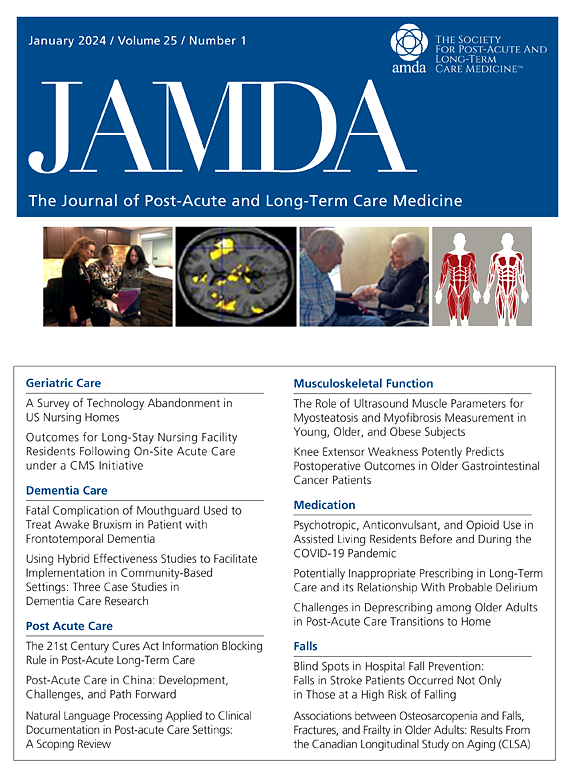Decoding the Enigmatic Link Between Sensory Impairment and Organic Mental Disorders: Insights From Biological Aging and Social Support in a Population Cohort Study
IF 3.8
2区 医学
Q2 GERIATRICS & GERONTOLOGY
Journal of the American Medical Directors Association
Pub Date : 2025-06-16
DOI:10.1016/j.jamda.2025.105709
引用次数: 0
Abstract
Objectives
The objective of this study was to investigate the association between sensory impairments and organic mental disorders. We also examined biological age acceleration as a potential mediator and social support as a potential moderator of this association.
Design
This was a longitudinal cohort study using Cox proportional hazards models with mediation and moderation analyses.
Setting and Participants
A total of 330,983 UK Biobank participants (mean age ± SD, 56.41 ± 8.09 years) were categorized into 4 groups: no sensory impairment (n = 60,636), hearing impairment (n = 22,297), visual impairment (n = 12,271), and dual-sensory impairment (n = 5757).
Methods
Sensory status was self-reported, biological age acceleration was assessed through 3 biomarkers (homeostasis disorder, Klemera-Doubal method biological age, and phenotypic age), and organic mental disorders were identified via International Classification of Diseases, 10th Edition codes (F00-F09) from national health registries. Survival analyses were adjusted for sociodemographic factors, lifestyle, and health status.
Results
Over a 13.85-year median follow-up, 9645 participants developed organic mental disorders. Dual-sensory impairment showed the strongest association [hazard ratio (HR), 1.54; 95% CI, 1.45-1.64], followed by visual (HR, 1.20; 95% CI, 1.12-1.28) and hearing impairment (HR, 1.12; 95% CI, 1.05-1.20). Biological age acceleration mediated 24.5% to 38.9% of these associations (strongest through Klemera-Doubal method biological age). Social support demonstrated significant moderating effects, particularly in dual-sensory impairment, where high social support reduced risk (HR, 1.34; 95% CI, 1.12-1.60) compared with low social support (HR, 4.76; 95% CI, 2.35-9.65).
Conclusions and Implications
Sensory impairments are associated with an increased risk of organic mental disorders, potentially partly mediated by accelerated biological aging, with social support demonstrating a significant moderating effect. The gradient of risk across impairment types and the substantial potential mediating effect of biological age acceleration are consistent with multiple pathways linking sensory and cognitive health. These findings indicate that comprehensive interventions targeting sensory health, biological aging, and social support may represent potential targets for interventions aimed at preventing cognitive disorders in aging populations.
解读感觉障碍和器质性精神障碍之间的神秘联系:一项人口队列研究中来自生物衰老和社会支持的见解。
目的:本研究的目的是探讨感觉障碍和器质性精神障碍之间的关系。我们还研究了生物年龄加速作为潜在的中介和社会支持作为这种关联的潜在调节因子。设计:这是一项纵向队列研究,采用Cox比例风险模型并进行中介和调节分析。环境和参与者:共有330,983名UK Biobank参与者(平均年龄±SD, 56.41±8.09岁)被分为4组:无感觉障碍(n = 60,636)、听力障碍(n = 22297)、视觉障碍(n = 12,271)和双感觉障碍(n = 5757)。方法:自我报告感觉状态,通过3种生物标志物(体内平衡障碍、klemera - dual法生物年龄和表型年龄)评估生物年龄加速,并通过国家卫生登记处的国际疾病分类第10版代码(F00-F09)确定器质性精神障碍。生存分析根据社会人口因素、生活方式和健康状况进行调整。结果:在13.85年的中位随访中,9645名参与者出现器质性精神障碍。双感觉障碍表现出最强的相关性(风险比[HR], 1.54;95% CI, 1.45-1.64),其次是目测(HR, 1.20;95% CI, 1.12-1.28)和听力障碍(HR, 1.12;95% ci, 1.05-1.20)。生物年龄加速介导了24.5%至38.9%的关联(通过klemera - double方法生物年龄最强)。社会支持表现出显著的调节作用,特别是在双感觉障碍中,高社会支持降低了风险(HR, 1.34;95% CI, 1.12-1.60)与低社会支持相比(HR, 4.76;95% ci, 2.35-9.65)。结论和意义:感觉障碍与器质性精神障碍的风险增加有关,可能部分由生物衰老加速介导,社会支持显示出显著的调节作用。不同损伤类型的风险梯度和生物年龄加速的潜在中介作用与连接感觉和认知健康的多种途径一致。这些发现表明,以感觉健康、生物老化和社会支持为目标的综合干预可能是预防老年人认知障碍的潜在目标。
本文章由计算机程序翻译,如有差异,请以英文原文为准。
求助全文
约1分钟内获得全文
求助全文
来源期刊
CiteScore
11.10
自引率
6.60%
发文量
472
审稿时长
44 days
期刊介绍:
JAMDA, the official journal of AMDA - The Society for Post-Acute and Long-Term Care Medicine, is a leading peer-reviewed publication that offers practical information and research geared towards healthcare professionals in the post-acute and long-term care fields. It is also a valuable resource for policy-makers, organizational leaders, educators, and advocates.
The journal provides essential information for various healthcare professionals such as medical directors, attending physicians, nurses, consultant pharmacists, geriatric psychiatrists, nurse practitioners, physician assistants, physical and occupational therapists, social workers, and others involved in providing, overseeing, and promoting quality

 求助内容:
求助内容: 应助结果提醒方式:
应助结果提醒方式:


